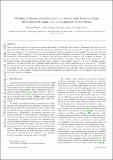Modeling of internal mechanical failure of all-solid-state batteries during electrochemical cycling, and implications for battery design
Author(s)
Bucci, Giovanna; Swamy, Tushar; Chiang, Yet-Ming; Carter, W Craig
DownloadCarter_Modeling of internal.pdf (3.449Mb)
OPEN_ACCESS_POLICY
Open Access Policy
Creative Commons Attribution-Noncommercial-Share Alike
Terms of use
Metadata
Show full item recordAbstract
This is the first quantitative analysis of mechanical reliability of all-solid state batteries. Mechanical degradation of the solid electrolyte (SE) is caused by intercalation-induced expansion of the electrode particles, within the constrains of a dense microstructure. A coupled electro-chemo-mechanical model was implemented to quantify the material properties that cause an SE to fracture. The treatment of microstructural details is essential to the understanding of stress-localization phenomena and fracture. A cohesive zone model is employed to simulate the evolution of damage. In the numerical tests, fracture is prevented when electrode-particle's expansion is lower than 7.5% (typical for most Li-intercalating compounds) and the solid-electrolyte's fracture energy higher than G[subscript c]= 4 J m⁻². Perhaps counter-intuitively, the analyses show that compliant solid electrolytes (with Young's modulus in the order of ESE= 15 GPa) are more prone to micro-cracking. This result, captured by our non-linear kinematics model, contradicts the speculation that sulfide SEs are more suitable for the design of bulk-type batteries than oxide SEs. Mechanical degradation is linked to the battery power-density. Fracture in solid Li-ion conductors represents a barrier for Li transport, and accelerates the decay of rate performance.
Date issued
2017-08Department
Massachusetts Institute of Technology. Department of Materials Science and EngineeringJournal
Journal of Materials Chemistry A
Publisher
Royal Society of Chemistry (RSC)
Citation
Bucci, Giovanna et al. “Modeling of Internal Mechanical Failure of All-Solid-State Batteries During Electrochemical Cycling, and Implications for Battery Design.” Journal of Materials Chemistry A 5, 36 (August 2017): 19422–19430 © 2017 The Royal Society of Chemistry
Version: Original manuscript
ISSN
2050-7488
2050-7496